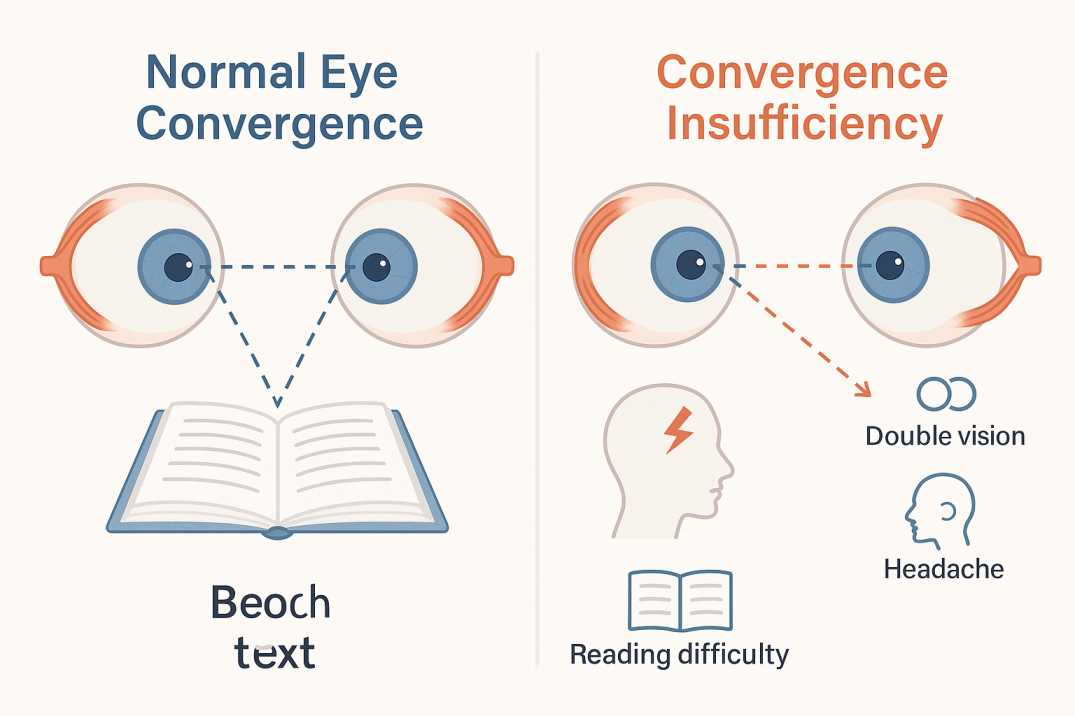Reading Difficulties? Vision Problems May Be the Hidden Cause

One in four struggling readers has undetected vision problems, not learning disabilities—discover the hidden cause behind reading challenges.
Key Takeaways
- 25% of children with reading difficulties have undiagnosed vision problems mistaken for dyslexia or ADHD
- Convergence insufficiency affects 5-13% of school-aged children, causing double vision and reading avoidance
- Standard school screenings fail to detect 75% of functional vision problems impacting academic performance
- Vision therapy yields 75-90% success rates for treating eye coordination, tracking, and focusing disorders
- Comprehensive vision evaluations differentiate vision problems from true learning disabilities
Understanding Vision-Related Reading Difficulties
When bright children struggle with reading despite intensive tutoring, parents often assume dyslexia. However, research reveals that 60% of brain function relates to vision processing—compared to just 8% for touch and 3% for hearing. This dominance means vision problems significantly impact reading in ways unrelated to phonological processing.
A comprehensive study in the Journal of Behavioral Optometry found that 85% of children with learning disabilities had significant deficits in at least one area of visual processing. These aren’t simple visual acuity issues detectable with standard eye charts—they’re functional vision problems affecting eye coordination, focusing, tracking, and visual information processing.
The Hidden Vision Problems Affecting Reading
Convergence Insufficiency: The Primary Culprit
Convergence insufficiency (CI) occurs in 2-13% of the U.S. population and appears three times more frequently in children with ADHD. This condition prevents the eyes from working together properly when focusing on near objects like books or tablets.
Normal reading requires convergence—both eyes pointing inward to maintain a single, clear image. With CI, the nerves controlling eye muscles malfunction, causing one eye to drift outward instead of converging.
Convergence Insufficiency Symptoms:
- Double or blurred vision during reading
- Words appearing to move, jump, or float
- Frequent loss of place while reading
- Headaches and eye strain after close work
- Difficulty concentrating on reading
- Re-reading lines or skipping words
- Closing or covering one eye
- Reading avoidance and fatigue
Children with CI often avoid reading due to eye strain, yet most don’t realize they see differently than their peers, making symptoms difficult to identify.
Binocular Vision Dysfunction (BVD)
BVD involves subtle eye misalignment, causing blurred, shadowed, or double vision. The brain forces eye muscles to constantly realign, creating immense visual strain. This misalignment-realignment cycle produces dizziness, clumsiness, poor depth perception, and reading challenges.
Many children with BVD receive misdiagnoses of ADD, ADHD, or dyslexia due to symptom overlap. Specialized aligning lenses correct the misalignment, eliminating muscle strain and enabling clear focus.
Strabismus and Amblyopia
Strabismus (eye misalignment) affects 4% of the U.S. population—approximately 13 million people. When eyes don’t point in the same direction simultaneously, it causes double vision, difficulty reading, eye strain, and depth perception problems.
Amblyopia (“lazy eye”) reduces visual acuity in one eye despite corrective lenses. Research shows amblyopia can reduce reading speed by 20-50% in natural, binocular reading. Amblyopic children also struggle with transferring test answers to Scantron sheets, compounding difficulties with timed assessments.
Eye Tracking Dysfunction
Research indicates that 80% of children with reading difficulties demonstrate saccadic eye movement deficiencies. Saccades are rapid eye movements allowing word-to-word and line-to-line tracking.
Dr. W.C. Maples of the Oklahoma College of Optometry notes that poor saccadic function can reduce reading speed by 50% and significantly impact comprehension, as children expend mental energy on tracking mechanics rather than understanding content.
Vision Problems vs. Dyslexia: Critical Differences
What Is Dyslexia?
Dyslexia is a neurobiological learning disability disrupting how the brain processes written language, affecting approximately 7% of people worldwide (potentially 20% including undiagnosed cases). It involves phonological processing deficits and language decoding difficulties.
Key Distinctions
Underlying Cause:
- Vision Problems: Physical issues with eye coordination, focusing, or tracking
- Dyslexia: Neurological differences in phonological processing and language decoding
Treatment Response:
- Vision Problems: Improve dramatically with vision therapy
- Dyslexia: Requires specialized reading instruction and phonological interventions
Symptom Patterns:
- Vision Problems: Worsen with fatigue and sustained near work; improve with breaks or monocular viewing
- Dyslexia: Consistent decoding, spelling, and phonological awareness difficulties regardless of fatigue
Important Note: Children can have both conditions simultaneously, requiring different interventions for each.
Why Standard Vision Screenings Miss the Problem
Standard school screenings focus exclusively on distance visual acuity (20/20 testing), missing critical visual skills for reading. Research published in Optometry and Vision Science found that school screenings failed to detect 75% of children with vision problems impacting learning.
What Screenings Miss:
- Eye teaming and convergence ability
- Focusing on flexibility and stamina
- Eye tracking and movement control
- Visual processing skills
- Accommodation disorders
- Binocular vision dysfunction
Vision screenings at school entry (ages 4-5) only test distance clarity and don’t assess functions required for comfortable reading vision.
Comprehensive Vision Evaluation Components
A thorough functional vision evaluation assesses:
- Visual acuity at multiple distances
- Eye teaming coordination
- Convergence ability testing
- Eye movement tracking and saccades
- Focusing skills and accommodation
- Depth perception (stereopsis)
- Visual processing capabilities
- Complete eye health examination
Academic Impact of Undetected Vision Problems
Reading Performance Effects
When students see blurry or double words, they expend extra effort maintaining single, clear vision, negatively impacting comprehension. These students focus on decoding individual words rather than reading fluently and understanding the overall meaning.
Writing and Mathematics
Vision problems affect multiple academic areas:
Writing Difficulties:
- Poor peripheral awareness causes difficulty writing straight
- Visualization deficits impair word recall
- Spatial concept issues interfere with word spacing
- Laterality problems cause letter confusion (b, d, p, q)
Mathematics Challenges: Research in the Journal of Learning Disabilities demonstrated that children with visual-spatial processing difficulties were three times more likely to struggle with mathematical concepts, including seeing decimals clearly, organizing work, and visualizing spatial relationships.
Behavior Misinterpretation
Children with eye-teaming problems appear inattentive because they constantly lose their place, while those with focusing issues seem to have short attention spans for near work. Dr. Eric Borsting’s research at Southern California College of Optometry found that children with convergence insufficiency scored significantly higher on standardized ADHD symptom scales.
Recent Scientific Research Supporting Vision-Reading Connections
Study 1: Convergence Insufficiency Treatment Trial (CITT-ART)
This multicenter randomized clinical trial involving 310 children aged 9-14 demonstrated that office-based vergence/accommodative therapy effectively treats symptomatic convergence insufficiency, with resulting improvements in clinical findings and symptom severity during reading tasks, plus parent-reported behavioral improvements.
Source: Effect of Vergence/Accommodative Therapy on Reading in Children with Convergence Insufficiency
Link: https://pmc.ncbi.nlm.nih.gov/articles/PMC6855328/
Study 2: Visual Dyslexia Research (2025)
Recent research published in Current Developmental Disorders Reports (February 2025) shows that visual magnocellular neuron development precedes and is essential for phonological awareness development. This challenges the purely phonological theory of dyslexia by demonstrating vision’s crucial first-step role in reading acquisition.
Source: Visual Dyslexia – Springer
Link: https://link.springer.com/article/10.1007/s40474-025-00316-3
Study 3: Amblyopia and Reading Speed
Research using natural, binocular silent reading demonstrated that amblyopic children read 20-50% slower than controls, regardless of amblyopia type, while comprehension remained normal, proving reading difficulty wasn’t due to dyslexia or learning disability.
Source: Amblyopia and Slow Reading
Link: https://pmc.ncbi.nlm.nih.gov/articles/PMC6050007/
Warning Signs: When to Seek Vision Evaluation
Physical and Behavioral Red Flags
Physical Symptoms:
- Frequent headaches after reading
- Eye strain or burning sensation
- Excessive tearing or rubbing eyes
- Squinting or closing one eye
Behavioral Indicators:
- Reading or homework avoidance
- Short attention span for near work
- Loss of place while reading
- Holding books unusually close/far
- Head tilting while reading
Performance Signs:
- Reading below grade level despite intelligence
- Poor comprehension
- Slow reading speed
- Difficulty copying from the board
- Letter reversals beyond age 7
Vision Therapy: Evidence-Based Treatment
What Is Vision Therapy?
Vision therapy is a structured, supervised program using convergence exercises and therapeutic activities to train the eyes and brain to work together effectively. It addresses neurological connections between the eyes and brain, improving eye muscle coordination, neural pathways, visual processing, focusing abilities, and tracking skills.
Treatment Components
In-Office Sessions:
- One-on-one work with a trained vision therapist
- 45-60 minute sessions, 1-2 times weekly
- Specialized equipment: lenses, prisms, computerized programs
- Progressive difficulty levels
Home Reinforcement:
- Daily 15-30 minute practice exercises
- Specific techniques for reinforcing new visual skills
Expected Outcomes
With consistent participation, vision therapy achieves:
- 75-90% success rates
- 25-50% reading speed improvements
- Significant symptom reduction
- Enhanced academic performance
- Improved sports and recreational abilities
- Long-term visual skill maintenance
The Cook Vision Therapy Center Advantage
Specialized Expertise
With over 40 years of experience, Dr. David Cook has established himself as a leading vision therapy authority. The Center’s exclusive focus on vision therapy—without routine eye exams or optical services—demonstrates true specialization in treating functional vision problems.
Comprehensive Services
Cook Vision Therapy Center treats:
- Convergence Insufficiency
- Strabismus (eye turns)
- Amblyopia (lazy eye)
- Binocular Vision Dysfunction
- Eye Tracking Disorders
- Accommodative Disorders
- Vision problems related to reading difficulties, learning challenges, sports performance, and post-concussion syndrome
Serving Metro Atlanta from Marietta, providing specialized care for families in Roswell, Duluth, Sandy Springs, and surrounding communities.
Taking Action: Your Next Steps
Step 1: Recognize the Signs
Review the warning signs in this article. If your child exhibits multiple symptoms and traditional interventions haven’t helped, vision problems may be contributing.
Step 2: Schedule Comprehensive Evaluation
Contact Cook Vision Therapy Center for a thorough functional vision examination—a 60-90 minute assessment testing multiple visual functions with detailed findings explanation and customized treatment recommendations.
Step 3: Begin Treatment
Early vision therapy intervention provides optimal outcomes. The brain’s neuroplasticity allows significant improvement at any age, though earlier intervention typically yields faster results.
Step 4: Support at Home
Success requires consistent therapy attendance, daily home activity completion, therapist communication about progress, and teacher coordination for classroom support.
Scientific Research & Citations
Primary Research Studies
1. Convergence Insufficiency Treatment Trial (CITT-ART)
- Link: https://pmc.ncbi.nlm.nih.gov/articles/PMC6855328/
- Finding: Office-based therapy effectively treats CI in children with symptom severity improvements
- Study Size: 310 children, multicenter randomized trial
2. Visual Dyslexia Research (February 2025)
- Link: https://link.springer.com/article/10.1007/s40474-025-00316-3
- Finding: Visual magnocellular neuron development precedes phonological awareness
- Significance: Demonstrates the crucial role in reading acquisition
3. Amblyopia and Reading Speed
- Link: https://pmc.ncbi.nlm.nih.gov/articles/PMC6050007/
- Finding: Amblyopic children read 20-50% slower with normal comprehension
- Impact: Proves reading difficulty unrelated to dyslexia/learning disability
Conclusion: Transform Lives Through Better Vision
Reading difficulties don’t always stem from learning disabilities. For one in four children, undetected vision problems create barriers that no amount of tutoring can overcome. Understanding the difference between vision-related reading struggles and true learning disabilities is crucial for appropriate intervention.
When vision problems are properly diagnosed and treated through vision therapy, children experience transformative improvements in reading comfort, speed, comprehension, and overall academic performance.
Schedule Your Comprehensive Vision Evaluation
Is your child’s reading difficulty actually a vision problem?
Cook Vision Therapy Center offers comprehensive vision evaluations, identifying functional vision problems that standard screenings miss. With over 40 years of specialized experience, Dr. David Cook and his team provide the expertise Atlanta families trust.
📞 Call Cook Vision Therapy Center Today 📍 Serving Metro Atlanta from Marietta 🎯 Specializing exclusively in vision therapy for over four decades
Don’t let undetected vision problems hold your child back another day.
FAQs
-
Adults may struggle with understanding text, following written instructions, retaining information, or avoiding reading tasks due to frustration or low confidence. These issues often stem from undiagnosed learning differences or attention disorders.



